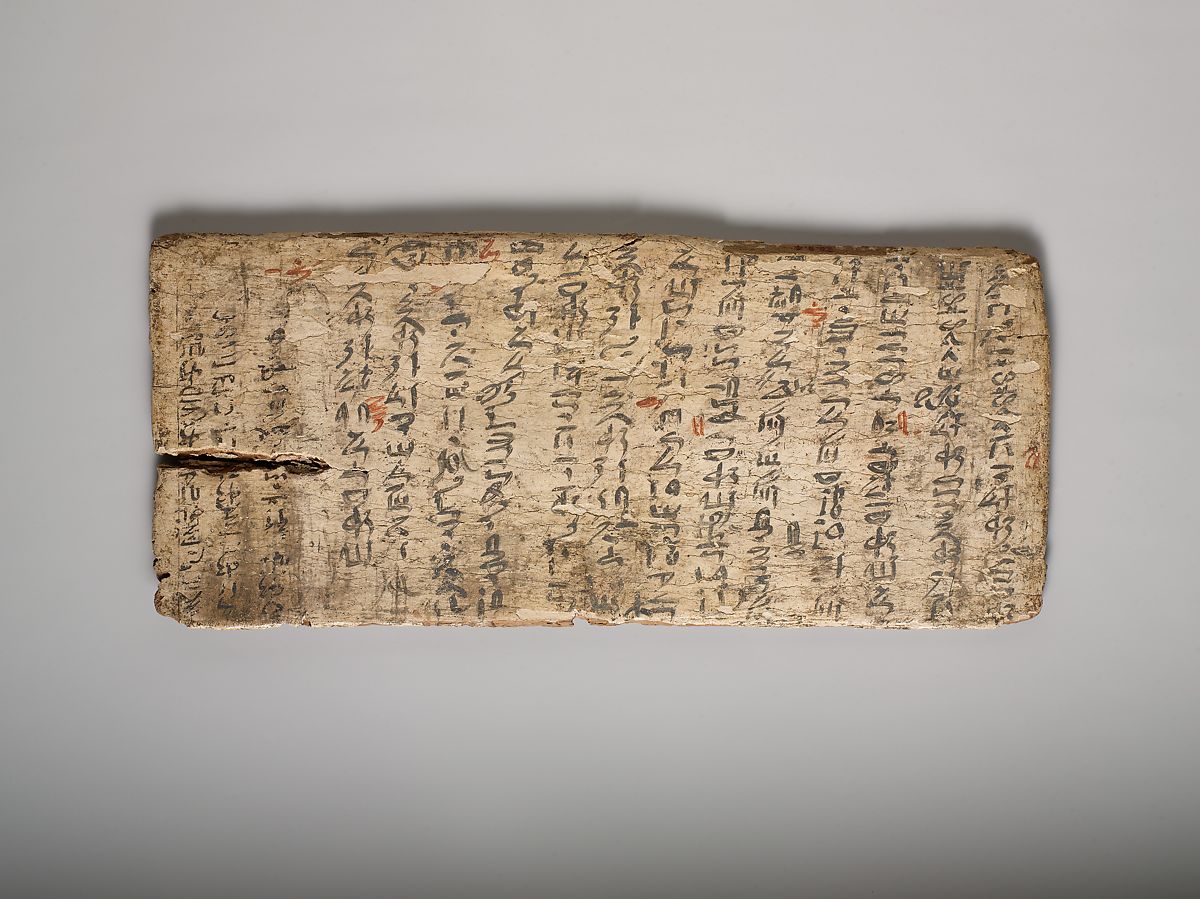
Americans raised on Laura Ingalls Wilder’s Little House books tend to associate slates with one room schoolhouses and rote exercises involving reading, writing and ‘rithmetic.
Had we been reared along the banks of the Nile, would our minds go to ancient gessoed boards like the 4000-year-old Middle Kingdom example above?
Like our familiar tablet-sized blackboards, this paper — or should we say papyrus? — saver was designed to be used again and again, with whitewash serving as a form of eraser.
As Egyptologist William C. Hayes, former Curator of Egyptian Art at the Metropolitan Museum wrote in The Scepter of Egypt: A Background for the Study of the Egyptian Antiquities in The Metropolitan Museum of Art. Vol. 1, From the Earliest Times to the End of the Middle Kingdom, the writing board at the top of the page:
…bears parts of two model letters of the very formal and ultra-poite variety addressed to a superior official. The writers consistently refer to themselves as “this servant” and to their addressees as “the Master (may he live, prosper, and be well.)” The longer letter was composed and written by a young man named Iny-su, son of Sekhsekh, who calls himself a “Servant of the Estate” and who, probably in jest, has used the name of his own brother, Peh-ny-su, as that of the distinguished addressee. Following a long-winded preamble, in which the gods of Thebes and adjacent towns are invoked in behalf of the recipient, we get down to the text of the letter and find that it concerns the delivery of various parts of a ship, probably a sacred barque. In spite of its formality and fine phraseology, the letter is riddled with misspellings and other mistakes which have been corrected in red ink, probably by the master scribe in charge of the class.
Iny-su would also have been expected to memorize the text he had copied out, a practice that carried forward to our one-room-schoolhouses, where children droned their way through texts from McGuffey’s Eclectic Readers.

Another ancient Egyptian writing board in the Met’s collection finds an apprentice scribe fumbling with imperfectly formed, unevenly spaced hieroglyphs.
Fetch the whitewash and say it with me, class — practice makes perfect.
The first tablet inspired some lively discussion and more than a few punchlines on Reddit, where commenter The-Lord-Moccasin mused:
I remember reading somewhere that Egyptian students were taught to write by transcribing stories of the awful lives of the average peasants, to motivate and make them appreciate their education. Like “the farmer toils all day in the burning field, and prays he doesn’t feed the lions; the fisherman sits in fear on his boat as the crocodile lurks below.”
Always thought it sounded effective as hell.
We can’t verify it, but we second that emotion.
Note: The red markings on the image up top indicate where spelling mistakes were corrected by a teacher.
via @ddoniolvalcroze
Related Content:
What Ancient Egyptian Sounded Like & How We Know It
Ayun Halliday is an author, illustrator, theater maker and Chief Primatologist of the East Village Inky zine. Follow her @AyunHalliday.


It is quite fascinating to see that it has been marked using correction codes! That’s what we, as teachers, are encouraged to follow in our present times.
To all those thumbsuckers in the Schools of Education who tremble at the thought of “doing violence” to their students by marking up papers with red ink, I say FIE! My red pen and I are backed by 4000 years of tradition, dating back to Ancient Egypt!
Because they did it 4000 years ago does not mean that it’s good. Many the practices of the “old days” have now been proven to be detrimental to the people who practiced it. For example, the farming practices of the Egyptians left the dirt depleted of nutrients hence the later starvation and ultimate demise of the population. There are many examples that show modern practices to be more beneficial. Progress, my friend. The advances in education/training also go “way back.” In fact, the whole thing about the BEST way to correct errors has been studied by the military (spoiler alert- in one fighter pilots learned faster in the group where the instructor was not yelling at the pilot.